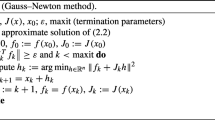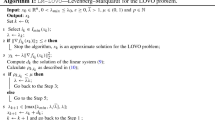Abstract
In this paper first, the method used for solving the weighted total least squares is discussed in two cases; (1) The parameter corresponding to the erroneous column in the design matrix is a scalar, model \(({\mathbf{H}} + {\mathbf{G}})^{T} {\mathbf{r}} + \delta \, = {\mathbf{q}} + {\mathbf{e}}\), (2) The parameter corresponding to the erroneous column in the design matrix is a vector, model \(({\mathbf{H}} + {\mathbf{G}})^{T} {\mathbf{r}} + {\varvec{\updelta}}\, = {\mathbf{q}} + {\mathbf{e}}\). Available techniques for solving TLS are based on the SVD and have a high computational burden. Besides, for the other presented methods that do not use SVD, there is need for large matrices, and it is needed to put zero in the covariance matrix of the design matrix, corresponding to errorless columns. This in turn increases the matrix size and results in increased volume of the calculations. However, in the proposed method, problem-solving is done without the need for SVD, and without introducing Lagrange multipliers, thus avoiding the error-free introducing of some columns of the design matrix by entering zero in the covariance matrix of the design matrix. It needs only easy equations based on the principles of summation, which will result in very low computing effort and high speed. Another advantage of this method is that, due to the similarity between this solving method and the ordinary least squares method, one can determine the covariance matrix of the estimated parameters by the error propagation law and use of other advantages of the ordinary least squares method.
Similar content being viewed by others
References
Akyilmaz O (2007) Total least squares solution of coordinate transformation. Surv Rev 39:68–80
Golub GH, Van Loan C (1980) An analysis of the total least squares problem. SIAM J Numer Anal 17:883–893
Golub G, Van Loan C (1996) Matrix computations, 3rd edn. John Hopkins University Press, Baltimore
Hamilton W (1964) For laboratory scientists (Book reviews: statistics in physical sciences. estimation, hypothesis testing, and least squares). Science 146:1570–1571
Henderson HV, Searle S (1981) On deriving the inverse of a sum of matrices. SIAM Rev 23:53–60
Huffel SV, Vandewalle J (1989) Analysis and properties of the generalized total least squares problem AX ≈ B when some or all columns in A are subject to error. SIAM J Matrix Anal Appl 10:294–315
Jazaeri S, Amiri-Simkooei A, Sharifi M (2014) Iterative algorithm for weighted total least squares adjustment. Surv Rev 46:19–27
Markovsky I, Rastello ML, Premoli A, Kukush A, Van Huffel S (2006) The element-wise weighted total least-squares problem. Comput Stat Data Anal 50:181–209
Neri F, Saitta G, Chiofalo S (1989) An accurate and straightforward approach to line regression analysis of error-affected experimental data. J Phys E: Sci Instrum 22:215
Schaffrin B (2006) A note on constrained total least-squares estimation. Linear Algebra Appl 417:245–258
Schaffrin B, Felus YA (2005) On total least-squares adjustment with constraints. In: A window on the future of geodesy, Springer
Schaffrin B, Felus YA (2008) Multivariate total least-squares adjustment for empirical affine transformations. In: VI Hotine-Marussi symposium on theoretical and computational geodesy, Springer, pp 238–242
Schaffrin B, Wieser A (2008) On weighted total least-squares adjustment for linear regression. J Geodesy 82:415–421
Schaffrin B, Lee I, Choi Y, Felus Y (2006) Total least-squares (TLS) for geodetic straight-line and plane adjustment. Bollettino di geodesia e scienze affini 65:141–168
Shen Y, Li B, Chen Y (2011) An iterative solution of weighted total least-squares adjustment. J Geodesy 85:229–238
VanHuffel S, Vandewalle J (1991) The total least squares problem: computational aspects and analysis. Siam, New Delhi
Xing F (2011) Weighted total least squares solutions for applications in geodesy, Fachrichtung Geodäsie und Geoinformatik der Leibniz-Univ
Author information
Authors and Affiliations
Corresponding author
Rights and permissions
About this article
Cite this article
Naeimi, Y., Voosoghi, B. A modified iterative algorithm for the weighted total least squares. Acta Geod Geophys 55, 319–334 (2020). https://doi.org/10.1007/s40328-020-00295-4
Received:
Accepted:
Published:
Issue Date:
DOI: https://doi.org/10.1007/s40328-020-00295-4




